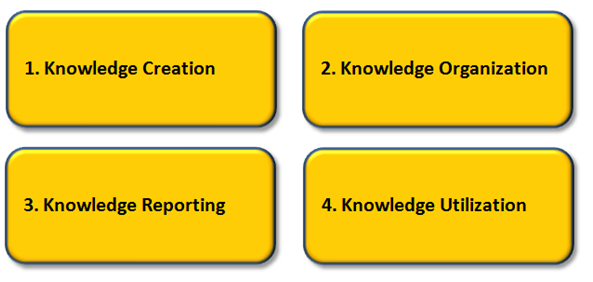Knowledge management is the process of gathering and administrating information already in the possession of a customer or organization and incorporating new information as it comes. Inadequate organization or the loss of knowledge due to a key employee’s departure from the business can have serious adverse effects on a company’s knowledge management. On the other hand, systematic knowledge acquisition, organization and retention can reduce expenses and even increase profits. Adrecom has developed a specific knowledge management system comprised of four basic stages to best extract and gather as of yet uncollected information and to administer existing information.
The Back Office was designed in order to allow your company to carry out this four-stage process. We will first start by briefly describing the stages behind this process and then how the Adrecom portal system can be used to implement it.
A Four-Stage Process
The Knowledge Management (KM) process consists of four stages: Knowledge Creation, Knowledge Organization, Knowledge Reporting and Knowledge Utilization and are each described in this post.

Knowledge Creation
If your information hasn’t already been to put to paper in
an organized fashion you need to find out where it’s located. Most often than
not, key information for the running of a system or organization is located
within employee knowledge, or in other words, in the minds of your employees.
Since you can’t manage information until its put to paper you have to first
find out how to collect the information that employees know. This process is
called Knowledge Creation and is completed in three steps.

Capture
The Capture step is where employees manually gather all of their knowledge in the form of raw data using forms, prompts, or bulk information feeds from a variety of sources. Generally speaking, there is little effort at this point to organize the information in any significant way, which is completed at a later stage. The key here is to put everything on the table.
Discovery
The Capture process helps in the Discovery step, which is where information that unknowingly already exists within your organization is discovered. The purpose of this step is not to begin organizing the information, but rather to make sure that all of it present before beginning to do so. This step also prevents the need to spend the time, effort and money relocating or recreating pertinent pieces of information; much less time is spent on discovering information now than on reinventing the wheel later.
Development
Employees begin the Development step by building upon information that they’ve manually gathered and discovered. This is achieved by looking through the information and adding anything to it that was missed in the initial capture step. The result is a thorough and comprehensive knowledge base that’s ready to be organized.
Knowledge Organization
The key to any KM system is the ability to organize created knowledge within a usable format. The next stage in Adrecom’s KM system is to verify all the knowledge brought forth by employees and to categorize and catalog it appropriately. Regular updates in the knowledge base helps build up the information in an accurate way while avoiding the need to repeat the Capture process. Conversely, information is entered into the knowledge base as it comes into being, thus contributing to an organized and wide knowledge base.
Knowledge Reporting
You cannot use the knowledge you’ve collected and organized without rendering it into an accessible format, which is why effective reporting methods are central to Adrecom’s KM system. Gathered knowledge can be stored and converted into any number of formats to facilitate intra-company communication. The type or types of formats used is largely dependent on the company’s choice.
All gathered knowledge may be filtered, converted to various formats and reported in various ways. This helps facilitate intra-company communications, as well as providing management with the data it needs to make informed business decisions.
Knowledge Utilization
All applications used in Adrecom’s KM system are custom fit for your organization’s specific needs. Whatever those needs may be, Adrecom produces system outputs and has designed applications and modules that can be used by your company to implement your goals.
Implementation
The Knowledge Creation step is usually carried out by your company on the premises. Once having “gone live” and completing the creation process, Adrecom helps give you a sense of comprehension when it comes to understanding how the information on your site is constructed and how to manage it. The Adrecom Back Office was made to store and classify virtually all forms of information your company might use. Specific sections were designed to house various forms of content, and sections exist to manage other administrative areas, such as event planning, marketing methods, resource collection and report creation. In other words, our portal solutions system serves as an organizational template for the data identified and converted into information via the Knowledge Management process. Once the conversion process is completed you can easily add information to your knowledge base, avoiding the need for any major overhauls in the future.




